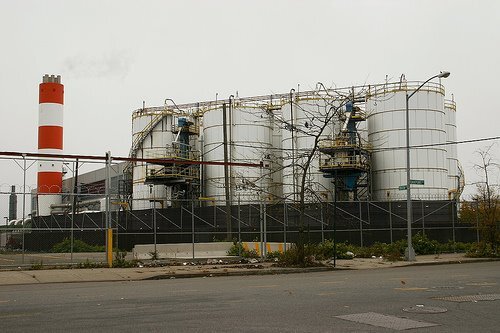There Was Never A New York "Pause" For The South Bronx
Blog Post by Jennifer Santos Ramirez, MPA, MPHIL, PhD Candidate, Public & Urban Policy
Here are some of the things you can't find during a pandemic: toilet paper, hand sanitizer, N95 masks, Nintendo Switches. As a kid growing up in the Hunts Point section of the South Bronx in the late '80s and early '90s, fresh air was a commodity we couldn't find either. No pandemic required.
Perhaps, it had something to do with the persistent stench that permeated our neighborhood from the nearby New York Organic Fertilizer Plant. This plant finally closed in 2010 due to an active environmental justice lawsuit led by ten local grassroots groups and the Natural Resources Defense Council. Still, it operated in Hunts Point for seventeen years, creating such noxious fumes that prevented us from playing outside, or even on the hottest days of late spring, prevented teachers from opening classroom windows to cool down. Despite the company's closure, the high levels of pollution in Hunts Point have been well documented and are not credited to just one infamous polluter. There are myriad of ways in which the South Bronx has suffered from environmental injustice for decades, making its residents the most vulnerable and at-risk for Covid-19 exposure.
New York Organic Fertilizer Plant *Photo courtesy of flickr/2kjb*
Others have made the connection to environmental injustice and Covid-19 exposure, but you won't find a more applicable example than in Hunts Point.
Hunts Point and the surrounding Mott Haven-Port Morris area of the South Bronx, is a peninsula entirely surrounded by highways, such as the Bruckner Expressway, Major Deegan and the Cross Bronx Expressway. These highways cause a large amount of particulate matter and black carbon that negatively impacts residents with respiratory illnesses, a majority of whom are black and Hispanic (1) (2). It is also home to the Hunts Point Food Distribution Center, which consists of three independent cooperative markets that supply an estimated 50% of the region's meat alone and 9% of the produce throughout the country (3). Because it is the largest food distribution center in the world, it is a critical piece of the United States food-chain supply. Bronx residents who work at one of the warehouses and facilities at the Center have never had an opportunity to work from home. Social distancing via Zoom is not an option.
Photo courtesy of Rebuild By Design
Despite recent federal and state funding to mitigate congestion and improve air quality, the distribution center and other commercial facilities require over 3,000 diesel trucks to travel in and out of the area every day to supply the region's supermarkets and restaurants with fresh meat and produce. Pollution attracts more pollution. This area (along with nearby East Harlem) is also the city's de facto "dumping ground" for industries and facilities no other NYC neighborhood would want or would stand for (anything below 96th street is basically NIMBY territory), such as MTA bus depots, solid waste transfer stations, powerplants, and incinerators.
A polluted environment creates and exacerbates some of our most pressing health issues. Covid-19 has exposed the vulnerability of communities of color to the virus in so many ways. From the economic consequences to the environmental ones. With one of the highest rates of hospitalization due to childhood asthma in the United States (4) (5) the South Bronx remains a microcosm for how our society treats communities of color, ignoring all of the environmental conditions in which a respiratory virus like Covid-19 would thrive, and setting up the current scenario we are in – where the rate of positive cases by population in the South Bronx far exceeds all other boroughs, and even as the number of cases in NY goes down, those positive for Covid-19 in the South Bronx are twice as likely to die from it (6).
As NYC starts to reopen gradually, the disparities between communities of color and wealthier, white neighborhoods nearby, are ever more apparent. There is still no government plan in place to protect workers in these vulnerable communities or prevent the situation in which they could fully recover from a major crisis. The South Bronx never got a pause, and as long as the local government continues to treat its residents as second-class citizens, the South Bronx never will.
1) Spira-Cohen, Ariel, et al. "Personal exposures to traffic-related particle pollution among children with asthma in the South Bronx, NY." Journal of exposure science & environmental epidemiology 20.5 (2010): 446-456.
2) Maroko, Andrew R., and Brian T. Pavilonis. "Peer Reviewed: Occupational Groups and Environmental Justice: A Case Study in the Bronx, New York." Preventing chronic disease 15 (2018).
3) Payne, Emily, et al. “Hunts Point Distribution Center: A Brief Overview with a Spotlight on the Produce Market.” NYC Food Policy Center, 5 Apr. 2018, www.nycfoodpolicy.org/hunts-point-distribution-center-brief-overview-spotlight-produce-market/.
4) Butini, Cecilia. “Asthma By The Numbers.” Medium, Asthma in the South Bronx, 30 Jan. 2018, medium.com/asthma-in-the-south-bronx/asthma-by-the-numbers-73553b2c9621.
5) Spira-Cohen, Ariel, et al. "Personal exposures to traffic-related air pollution and acute respiratory health among Bronx schoolchildren with asthma." Environmental health perspectives 119.4 (2011): 559-565.
6) “COVID-19: Data.” COVID-19: Data Summary - NYC Health, www1.nyc.gov/site/doh/covid/covid-19-data.page.


